Container gardening in Florida can produce a lot of veggies and is a great option to keep your gardening dreams alive if all you have to work with is a small patio or balcony.
You can grow almost any vegetable in a container. There are lots of dwarf varieties that you can choose to grow in pots, from lettuces to tomatoes to cucumbers to beans. Your choices are not limited, below are Florida friendly dwarf varieties of common veggies.
Veggie – Variety
- French bean – Golden Child, Allicante
- Beet – Babby Ball
- Cabbage – Baby Pixie
- Carrot – Little finger, Parisian, Round Romeo, Atlas
- Cauliflower – Snowball
- Cucumber – Very Kuhl, Spacemaster, Bush Champion
- Eggplant – Bambino, Pot Black
- Kale – Dwarf Blue Curled
- Lettuce – Tom Thumb, Little Gem, Bambi, Claremont
- English Pea – Little Marvel, Half Pint
- Pumpkin – Jack Be Little, Small Sugar, Baby Boo
- Tomato – Patio, Small Fry, Tiny Tim
The same rules apply to container gardening as they do to regular gardening. You need full sun, good soil, and water.
What can I grow in containers in Florida?
You can grow almost any veggie in a pot that you can grow in a garden. You need to just choose the correct variety to grow.
Choosing something that requires lots of room to spread and grow is a sure way to have a spindly, unhealthy plant in a container. Larger plants require a larger root system, something that container gardening limits.
Don’t get me wrong, I’m not saying that you can’t grow a beefsteak tomato in a pot. You can, I’m just assuming that if you’re looking for container gardening ideas, you are probably not working with a lot of space.
Dwarf varieties have been designed so that they are grown smaller but still produce pounds of fruit. As you can see on the list above your choices are not limited. You can grow pumpkins, lettuce, Kale, cucumber, tomato, and eggplant.
And that’s just the veggies, You can grow almost any herb that you want including basil, mint or oregano.
Fruit trees are also an option to grow in containers. The big benefit to grow long-lived trees in containers is mobility. You can move them to a better location when you know that it’s either gonna get cold or be too hot for the plant to enjoy life.
Planting in a container
You want to make sure that your container has good drainage.
Some people put coffee filters (or something similar) on the bottom of their pots before putting any soil in.
I’ve never tried it, but they say it helps with keeping soil in the pot and not falling out of the drainage holes.
I’ve never had a problem with this really but I usually lay down a thin layer of rocks in the bottom of my pots. I think it helps drainage.
If you are planting seeds directly into your pot then just fill that bad boy almost to the top with dirt. Leave about two inches or so of room so that you can add mulch.
If you are working with transplants then add a few inches of soil first. You want your plant’s base to about at the top of the container.
Fill the rest of the pot around your transplant with dirt.
In both cases don’t compact the soil. Loose soil helps plants roots spread.
And be sure to add mulch.
When can I plant these veggies in containers?
The same rules apply to container gardening as they do as if you were planting in the ground or raised bed. Our climate here in Florida is different than the rest of the United States, we have different timing than most. Our most productive seasons are spring and fall.
Not summer, like most of the others.
Our north Florida friends have a schedule that is most like the other states but they are still different. Follow this planting chart to help you decide when you should plant what.
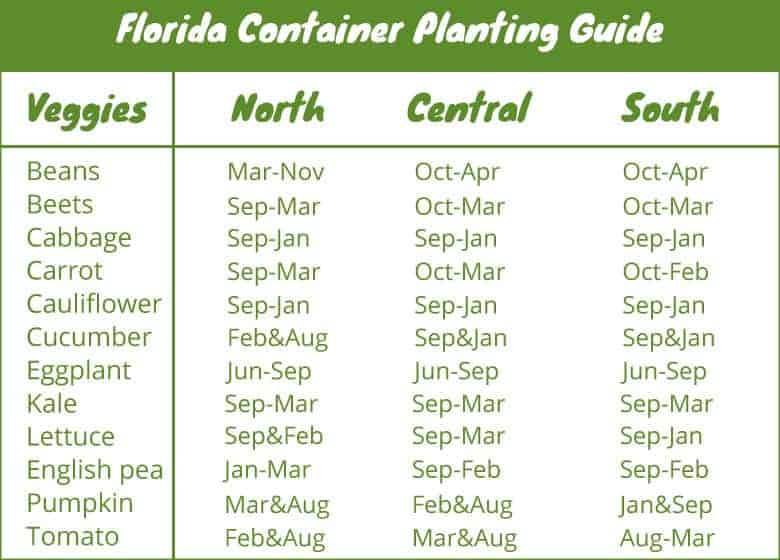
What are the advantages and disadvantages of growing in pots?
The advantages of growing in a container are soil control and mobility. The best thing of all about container gardening is that you can easily control the soil.
Adding amendments to our natural Florida soil is a lot more work than just filling up a container with good dirt.
We have mostly sandy soils. we will have to add A LOT of organic materials to get our dirt to where it needs to be to grow good veggies.
It’s not impossible, it’s just a pain. Growing in a container or pot eliminates that issue.
Usually, you would have to rotate your vegetables if planting directly into the ground.
If you continuously plant the same vegetable in the same spot, you are inviting disease.
It actually doesn’t even have to be the same veggie, they just have to belong to the same family.
They use similar nutrients from the soil and attract the same kinda bugs.
In containers, you can plant tomatoes year after year because you can just remove the soil and replace it with fresh, nutrient-rich soil every time.
You also have the benefit of being able to move your plant inside if you know a freeze or some frost is on its way.
You can also move your plants with the sun if needed too. Giving you the ability to ensure that your plants get the minimum number of hours of sun that they need.
What soil do I need for a container garden?
Every plant is different but there is a general rule of thumb that your soil needs to hold water but not too much. It needs to have air pockets that let the roots breath and water flow freely. It also needs to provide good footing for your plant. I have found the best luck with his mix:
- ½ peat moss
- ½ compost
- Worm castings for fertilizer
- Fungi additive to create an internet of nutrients, making them easily available to your plants.
Container gardening saves you from dealing with Florida’s soil which normally isn’t the best for veggies.
Building, or buying, the perfect soil is a major benefit of container gardening.
So you really want to leverage that and make sure that your soil is perfect.
You might also be interested: Can you garden in Florida soil?
How do I fertilize a container garden?
Fertilizing veggies is an important part of being successful. Almost all the fertilizers that you will see at your garden store have three numbers on the bag. These are your N-P-K values.
This stands for the amount of Nitrogen(N)-Phosphorous(P)-Potassium(K) that is in the fertilizer.
Each nutrient does something different for your plant.
Nitrogen encourages green leafy growth, which would be great for growing leafy greens like lettuce, kale, collards, chards etc…
Too much nitrogen though can hurt a plant whose main goal is to produce fruit, like a tomato. You will end up with a huge plant full of lots of green leaves but no fruit.
Phosphorus and is used by the plant to set flowers and produce fruit, which is extremely helpful for veggies like tomatoes and other fruit producers.
Potassium is used by the plant for multiple things, making a good booster of overall health.
I like to use two different fertilizers. For my leafy greens, I used this liquid fish emulsion fertilizer(Check price on Amazon). It’s nitrogen focused (5-1-1-) and super easy to spray on and water with.
For my other veggies I use Tomato-tone(Check price on Amazon), it’s a 3-4-6 granular fertilizer that is super easy to sprinkle on your dirt.
Every time you water, nutrients are flowing out of the soil.
Always follow the directions on the bottle.
But once my plants are established, meaning they have a few sets of true leaves, I begin fertilizing once every two weeks.
How often do I water a container garden?
Container gardening in Florida’s hot ass weather means you will have to water often.
At the very least, once a day maybe even twice a day depending on what you’ve got planted. Veggies like tomatoes are heavy feeders and require plenty to drink.
You will know it’s time to water when the top few inches of soil are dry. Get your finger dirty, give your soil a poke. Are the top few inches dry?
Give them a drink.
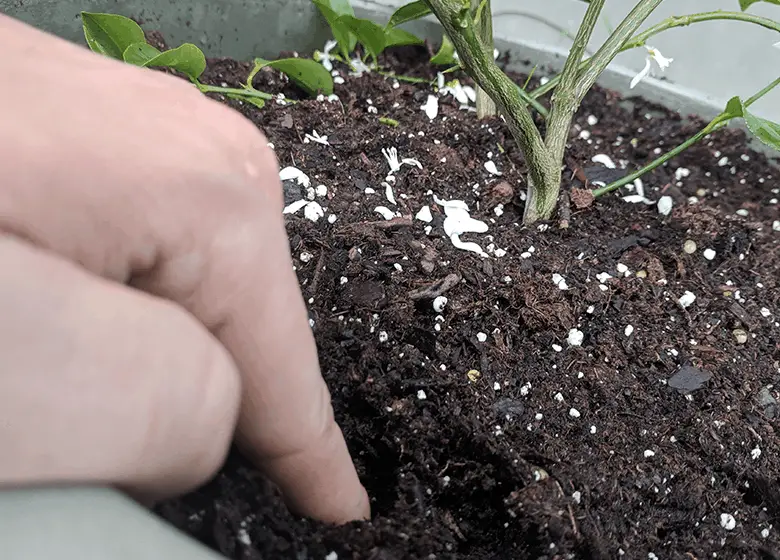
Some plants will look all droopy and sad too, that’s their way of asking for a drink.
You wanna water them before they look like this though.
Also cooler weather will change the frequency of watering. In our fall and winter months here in Florida you will not have to water as much compared to our summer months.
Container Gardening Layout
Planning out your garden is a super helpful practice. It helps you get a realistic view of what you are actually working with.
I’ve found it pretty easy to have my garden get out of hand if I don’t visualize what I’ve got going on.
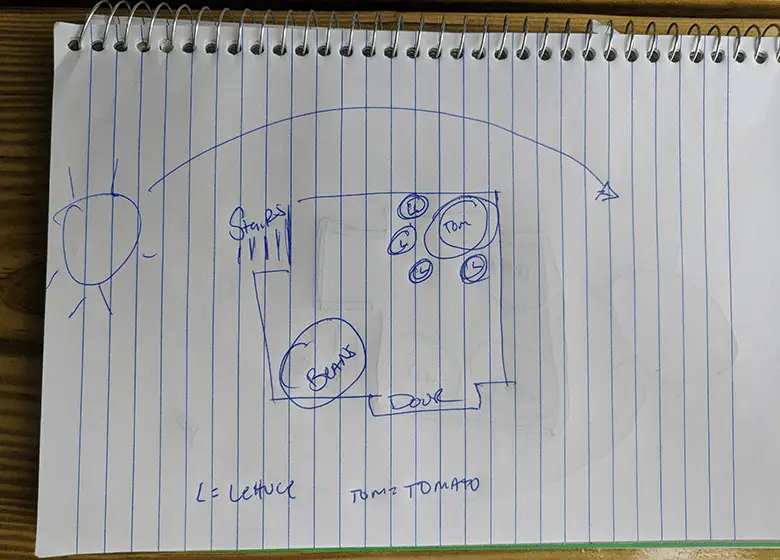
I’ll want to plant like 23 things but actually only have room for about 5 things.
A well-planned garden of 5 plants will produce more than a poorly planned garden of 23.
Your planning doesn’t have to be anything fancy, just some simple sketches.
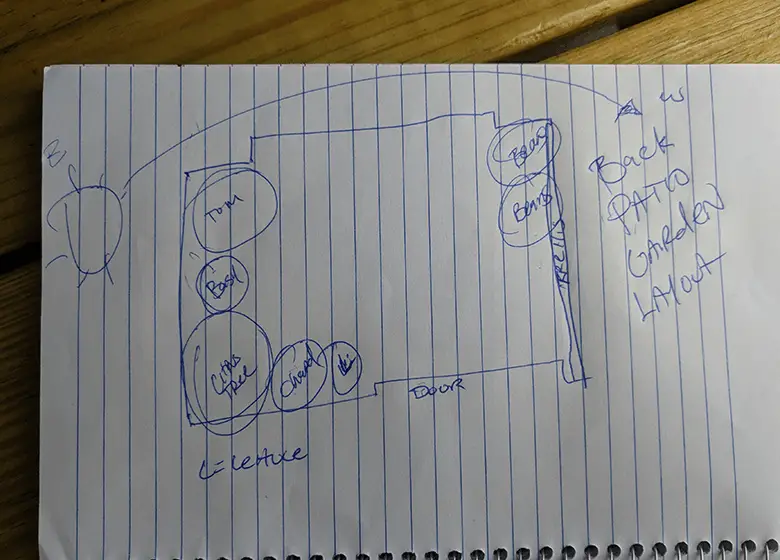
What is the best container to garden with?
It depends on what plants you are going to grow. Choosing a pot that is too small will ensure that you veggies won’t produce but choosing a pot that is too large will cause you to spend more money on soil that you don’t need.
Veggies like lettuce, carrots, beets, and many herbs don’t require a deep space to grow roots.
Vegetables like tomatoes, eggplant, peppers, and beans require more space to spread their feet. So depending on what you are trying to grow your container needs will change.
Vegetables like peppers, eggplants and squash will need an 18-24 inch diameter pot
Herbs and lettuces will need pots that are 10-14 inch diameter pots.
Should you choose clay, plastic, wood, ceramic or cement pots?
This also depends on a few things. If your budget is what you are concerned about, clay and plastic pots are super affordable. However, clay pots are easily broken and It’s been my experience with plastic pots that I seem to have to water them more frequently. For whatever reason that’s been my experience with plastic pots, that has not been everybody’s, some say they have to water less.
Concrete pots are super heavy and hard to move but there are lots of really cool looking concrete pots, they are usually on the more expensive side though.
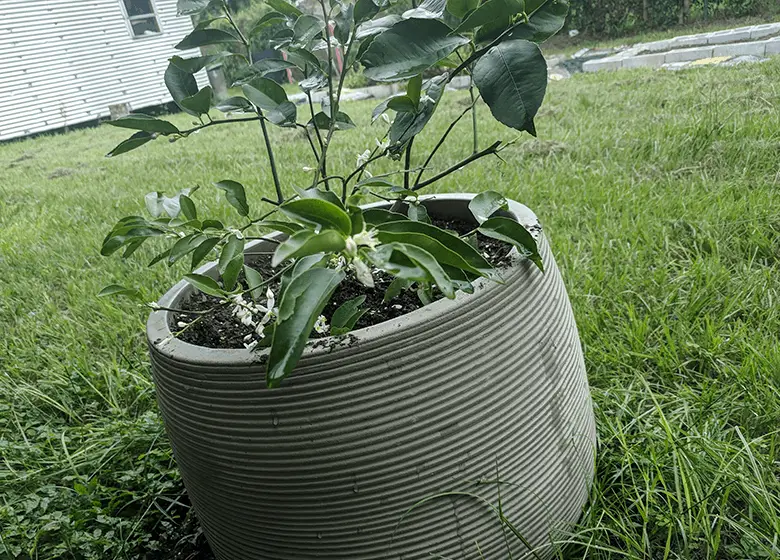
Wooden pots, like half barrels, are great for planting but begin to fall apart after a few seasons. They do add a really nice rustic touch.
Glazed ceramic pots have a cool look and are durable but they are also heavy and costly.
Florida Container Gardening
You can grow more than you probably thought you could in containers. You can have a nice looking little garden with just a few pots. You can plant lettuce, kales, tomatoes, eggplants, peppers and all sorts of herbs. All of the normal vegetables that you think of when it comes to gardening. If you get dwarf varieties of these common vegetables you will have no problem producing a fruitful garden.
